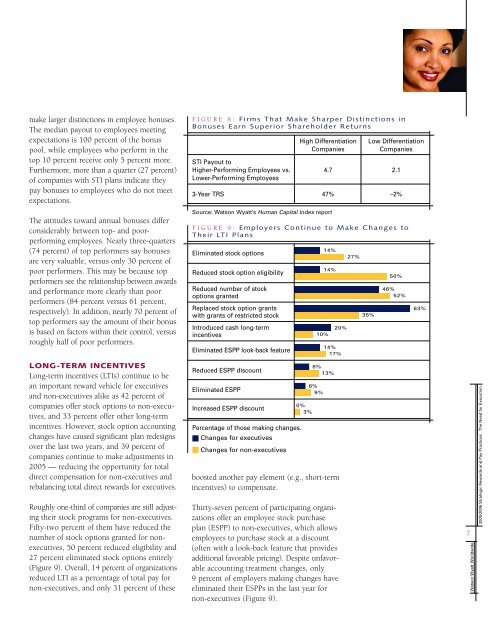The Need for Execution - San Antonio Compensation Association
The Need for Execution - San Antonio Compensation Association
The Need for Execution - San Antonio Compensation Association
You also want an ePaper? Increase the reach of your titles
YUMPU automatically turns print PDFs into web optimized ePapers that Google loves.
make larger distinctions in employee bonuses.<br />
<strong>The</strong> median payout to employees meeting<br />
expectations is 100 percent of the bonus<br />
pool, while employees who per<strong>for</strong>m in the<br />
top 10 percent receive only 5 percent more.<br />
Furthermore, more than a quarter (27 percent)<br />
of companies with STI plans indicate they<br />
pay bonuses to employees who do not meet<br />
expectations.<br />
FIGURE 8: Firms That Make Sharper Distinctions in<br />
Bonuses Earn Superior Shareholder Returns<br />
High Differentiation<br />
Companies<br />
Low Differentiation<br />
Companies<br />
STI Payout to<br />
Higher-Per<strong>for</strong>ming Employees vs. 4.7 2.1<br />
Lower-Per<strong>for</strong>ming Employees<br />
3-Year TRS 47% –2%<br />
<strong>The</strong> attitudes toward annual bonuses differ<br />
considerably between top- and poorper<strong>for</strong>ming<br />
employees. Nearly three-quarters<br />
(74 percent) of top per<strong>for</strong>mers say bonuses<br />
are very valuable, versus only 30 percent of<br />
poor per<strong>for</strong>mers. This may be because top<br />
per<strong>for</strong>mers see the relationship between awards<br />
and per<strong>for</strong>mance more clearly than poor<br />
per<strong>for</strong>mers (84 percent versus 61 percent,<br />
respectively). In addition, nearly 70 percent of<br />
top per<strong>for</strong>mers say the amount of their bonus<br />
is based on factors within their control, versus<br />
roughly half of poor per<strong>for</strong>mers.<br />
Source: Watson Wyatt’s Human Capital Index report<br />
FIGURE 9: Employers Continue to Make Changes to<br />
<strong>The</strong>ir LTI Plans<br />
Eliminated stock options<br />
Reduced stock option eligibility<br />
Reduced number of stock<br />
options granted<br />
Replaced stock option grants<br />
with grants of restricted stock<br />
Introduced cash long-term<br />
incentives<br />
Eliminated ESPP look-back feature<br />
10%<br />
14%<br />
14%<br />
20%<br />
14%<br />
17%<br />
27%<br />
35%<br />
50%<br />
46%<br />
52%<br />
63%<br />
LONG-TERM INCENTIVES<br />
Long-term incentives (LTIs) continue to be<br />
an important reward vehicle <strong>for</strong> executives<br />
and non-executives alike as 42 percent of<br />
companies offer stock options to non-executives,<br />
and 33 percent offer other long-term<br />
incentives. However, stock option accounting<br />
changes have caused significant plan redesigns<br />
over the last two years, and 39 percent of<br />
companies continue to make adjustments in<br />
2005 — reducing the opportunity <strong>for</strong> total<br />
direct compensation <strong>for</strong> non-executives and<br />
rebalancing total direct rewards <strong>for</strong> executives.<br />
Roughly one-third of companies are still adjusting<br />
their stock programs <strong>for</strong> non-executives.<br />
Fifty-two percent of them have reduced the<br />
number of stock options granted <strong>for</strong> nonexecutives,<br />
50 percent reduced eligibility and<br />
27 percent eliminated stock options entirely<br />
(Figure 9). Overall, 14 percent of organizations<br />
reduced LTI as a percentage of total pay <strong>for</strong><br />
non-executives, and only 31 percent of these<br />
Reduced ESPP discount<br />
Eliminated ESPP<br />
Increased ESPP discount<br />
Percentage of those making changes.<br />
Changes <strong>for</strong> executives<br />
Changes <strong>for</strong> non-executives<br />
0%<br />
3%<br />
8%<br />
13%<br />
6%<br />
9%<br />
boosted another pay element (e.g., short-term<br />
incentives) to compensate.<br />
Thirty-seven percent of participating organizations<br />
offer an employee stock purchase<br />
plan (ESPP) to non-executives, which allows<br />
employees to purchase stock at a discount<br />
(often with a look-back feature that provides<br />
additional favorable pricing). Despite unfavorable<br />
accounting treatment changes, only<br />
9 percent of employers making changes have<br />
eliminated their ESPPs in the last year <strong>for</strong><br />
non-executives (Figure 9).<br />
7<br />
Watson Wyatt Worldwide<br />
2005/2006 Strategic Rewards and Pay Practices: <strong>The</strong> <strong>Need</strong> <strong>for</strong> <strong>Execution</strong>


